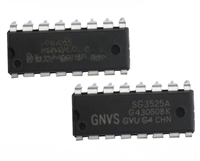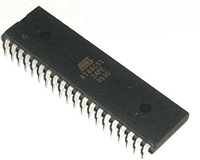| 是否无铅: | 含铅 | 是否Rohs认证: | 符合 |
| 生命周期: | Active | 零件包装代码: | TSSOP |
| 包装说明: | TSSOP, TSSOP16,.25 | 针数: | 16 |
| Reach Compliance Code: | compliant | ECCN代码: | EAR99 |
| HTS代码: | 8542.39.00.01 | 风险等级: | 5.24 |
| Samacsys Confidence: | 3 | Samacsys Status: | Released |
| 2D Presentation: | https://componentsearchengine.com/2D/0T/578578.3.1.png | Schematic Symbol: | https://componentsearchengine.com/symbol.php?partID=578578 |
| PCB Footprint: | https://componentsearchengine.com/footprint.php?partID=578578 | 3D View: | https://componentsearchengine.com/viewer/3D.php?partID=578578 |
| Samacsys PartID: | 578578 | Samacsys Image: | https://componentsearchengine.com/Images/9/AD7357YRUZ-RL.jpg |
| Samacsys Thumbnail Image: | https://componentsearchengine.com/Thumbnails/3/AD7357YRUZ-RL.jpg | Samacsys Pin Count: | 16 |
| Samacsys Part Category: | Integrated Circuit | Samacsys Package Category: | Small Outline Packages |
| Samacsys Footprint Name: | 16 PIN TSSOP | Samacsys Released Date: | 2017-01-11 11:21:59 |
| Is Samacsys: | N | 最大模拟输入电压: | 1.6 V |
| 最小模拟输入电压: | 0.5 V | 最长转换时间: | 0.238 µs |
| 转换器类型: | ADC, SUCCESSIVE APPROXIMATION | JESD-30 代码: | R-PDSO-G16 |
| JESD-609代码: | e3 | 长度: | 5 mm |
| 最大线性误差 (EL): | 0.0183% | 湿度敏感等级: | 1 |
| 模拟输入通道数量: | 2 | 位数: | 14 |
| 功能数量: | 1 | 端子数量: | 16 |
| 最高工作温度: | 125 °C | 最低工作温度: | -40 °C |
| 输出位码: | BINARY | 输出格式: | SERIAL |
| 封装主体材料: | PLASTIC/EPOXY | 封装代码: | TSSOP |
| 封装等效代码: | TSSOP16,.25 | 封装形状: | RECTANGULAR |
| 封装形式: | SMALL OUTLINE, THIN PROFILE, SHRINK PITCH | 峰值回流温度(摄氏度): | 260 |
| 电源: | 2.5 V | 认证状态: | Not Qualified |
| 采样速率: | 4.2 MHz | 采样并保持/跟踪并保持: | TRACK |
| 座面最大高度: | 1.2 mm | 子类别: | Analog to Digital Converters |
| 标称供电电压: | 2.5 V | 表面贴装: | YES |
| 技术: | CMOS | 温度等级: | AUTOMOTIVE |
| 端子面层: | Matte Tin (Sn) | 端子形式: | GULL WING |
| 端子节距: | 0.65 mm | 端子位置: | DUAL |
| 处于峰值回流温度下的最长时间: | 30 | 宽度: | 4.4 mm |
| Base Number Matches: | 1 |
| 型号 | 品牌 | 描述 | 获取价格 | 数据表 |
| AD7357YRUZ-500RL7 | ADI | Differential Input,Dual,Simultaneous Sampling, 4.25 MSPS, 14-Bit, SAR ADC |
获取价格 |

|
| AD7357YRUZ-RL | ADI | Differential Input,Dual,Simultaneous Sampling, 4.25 MSPS, 14-Bit, SAR ADC |
获取价格 |

|
| AD736 | ADI | Low Cost, Low Power, True RMS-to-DC Converter |
获取价格 |

|
| AD736_12 | ADI | Low Cost, Low Power, True RMS-to-DC Converter |
获取价格 |

|
| AD7366 | ADI | True Bipolar Input, Dual 1us, 12-Bit, 2-Channel SAR ADC |
获取价格 |

|
| AD7366_07 | ADI | True Bipolar Input, Dual 1 レs, 12-/14-Bit, 2- |
获取价格 |

|
 SG3525资料手册详解:SG3525参数分析、引脚说明、应用介绍
SG3525资料手册详解:SG3525参数分析、引脚说明、应用介绍

 AT89C51单片机资料手册详细解析及应用示例
AT89C51单片机资料手册详细解析及应用示例

 CP2102资料手册解读:CP2102引脚说明、关键参数分析
CP2102资料手册解读:CP2102引脚说明、关键参数分析

 资料手册解读:UC3842参数和管脚说明
资料手册解读:UC3842参数和管脚说明
